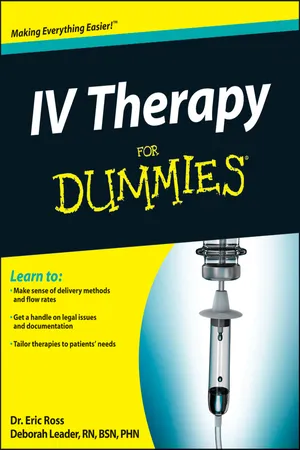Chapter 1
Introducing IV Therapy: A Purpose-Driven Practice
In This Chapter
Exploring the types of IVs and the different methods of administration
Figuring out what your role is in IV therapy
Getting familiar with standards of care to protect yourself and your patient
Intravenous (IV) therapy is more than just another medical procedure. It’s a universal method of saving lives and restoring health that healthcare facilities all around the world use every day.
In this chapter, you find out how IV medications work to restore vital signs and relieve pain, and you get a glimpse of the various types of IVs used to treat clinical conditions, as well as the assorted methods of administering them. You take a journey through all aspects of IV therapy, including starting, monitoring, and discontinuing IVs, and you explore important methods of promoting patient safety and preventing complications. Finally, you get a closer look at the medical-legal implications of IV therapy and the importance of performing to national standards of care, particularly those set by the Infusion Nurses Society (INS).
What’s the Point? The Purpose of IV Therapy
Doctors prescribe IV therapy when they need to deliver fluids and medications quickly, copiously, and frequently. They also use it to administer products like blood, parenteral nutrition, and chemotherapy that can’t be delivered any other way.
As a healthcare worker, you use IVs to administer all types of therapies, ranging from a simple normal saline drip to hydrate a depleted marathon runner to a sophisticated thrombolytic drug infusion to dissolve blood clots in a patient who just had a heart attack. Regardless of which type of therapy you use them for, the main purpose of IVs is to save lives.
Administering emergency fluids and medications
During emergencies, you use IV fluids and medications for countless reasons, including the following:
To stabilize blood pressure
To dilate bronchial tubes in patients with asthma
To convert heart arrhythmias back to sinus rhythm
To relax vocal cords to facilitate intubation
To restore blood volume to prevent circulatory collapse
In short, IV fluids and medications are vital, irreplaceable elements in an emergency response, and they frequently make the difference between life and death. For details on preparing for and administering IV therapy, check out Parts III and IV.
Delivering pharmacological agents
When patients need to receive medications quickly, frequently, or over a long period of time, the intravenous route is the method of choice. The use of IV medications has skyrocketed since the advent of modern IV therapy in World War I. Today, every department of the hospital, from intensive care to medical-surgical units to labor and delivery and beyond, uses IV medications.
Nurses who administer IV medications must know how to administer IV drugs safely, prevent potential complications from both the drug itself and the IV, and monitor the patient’s response to therapy. For details on administering IV medications and managing complications, go to Chapter 14. For drug classifications and other IV medication basics, see Chapter 4.
Replacing blood and blood products
Since the first successful human blood transfusion was performed in 1818, blood transfusions have become a mainstay in replacing blood lost through injury, surgery, or disease. Today, more than 5 million people receive blood transfusions each year in the U.S. alone.
Blood transfusions through IV therapy are now routine and relatively safe. In fact, the greatest danger patients face when receiving blood today is having a life-threatening reaction caused by getting the wrong blood type by accident. That’s where knowing more about IV therapy becomes essential.
Because nurses administer the vast majority of blood and blood components, they’re the last safety net to ensure delivery of compatible blood products. But even with all the safety precautions of initially checking the blood and verifying it again at the bedside, patients still die from blood incompatibilities every year. The biggest key to preventing deaths and other complications related to the administration of whole blood or blood products is a vigilant nurse. To find out more about administering blood components safely and preventing complications, check out Chapters 5 and 15.
Administering chemotherapy medications
Chemotherapy drugs are cytotoxic (cell-killing) substances designed to attack and kill cancer cells. Unfortunately, chemotherapy can’t distinguish between malignant cells and healthy cells, so it also destroys healthy cells and causes a cascade of debilitating side effects. Yet, even though the side effects may be severe and crippling, millions of cancer patients each year elect to undergo chemotherapy to combat the devastating effects of cancer.
Chemotherapy is a risky business for both the patient and the IV nurse. Patients are at risk for vein destruction and tissue necrosis if the IV becomes infiltrated, and IV nurses are at risk for chemical burns to the eyes, face, or hands when preparing and administering the drugs. In addition, long-term side effects of leukemia and blood abnormalities have been observed in oncology nurses with chronic exposure to chemotherapy agents.
Fortunately, awareness and technology eliminate some of these risks. For instance, nurses use implanted ports to reduce the risk of infiltration and leakage of toxic drugs into surrounding tissues in the patient. Nurses also use high-tech safety gear and protective equipment that shield their face, arms, and hands from the accidental spilling or splashing of toxic chemicals.
Despite the risks, more than 100,000 doses of chemotherapy are given around the world every day, and IV nurses are a critical component in delivering this life-saving therapy. For more on how chemotherapy works, check out Chapter 6. For details on how to administer chemotherapy, turn to Chapter 16.
Maintaining fluid and electrolyte balance
To function properly, the human body must keep fluid in its cells, between its cells, and in the bloodstream. The body maintains a state of equilibrium by keeping a vigilant watch over...










